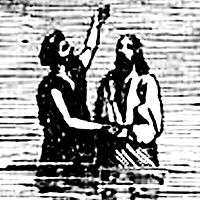John Smyth (Baptist minister)
| Part of a series on |
| Baptists |
|---|
 |
|
Background |
|
|
John Smyth (c. 1570 – c. 28 August 1612) was an early Baptist minister of England and a defender of the principle of religious liberty. Historians consider John Smyth a founder of the Baptist churches.
Early life
Smyth is thought to have been the son of John Smyth, a yeoman of Sturton-le-Steeple, Nottinghamshire.[1] He was educated locally at the grammar school in Gainsborough and in Christ's College, Cambridge, where he became a Fellow in 1594.[2]
Ordination
Smyth was ordained as an Anglican priest in 1594 in England. He preached in the city of Lincoln in 1600 to 1602.[3] Soon after his ordination, he broke with the Church of England and left for Holland where he and his small congregation began to study the Bible ardently. He briefly returned to England.
Believer's baptism
In 1609, Smyth, along with a group in Holland, came to believe in believer's baptism (as opposed to infant baptism) and they came together to form one of the earliest Baptist churches. Baptists believe that baptism is a sign of obedience to God.[Mt. 28:19-20] Baptists also believe that baptism by immersion is pictorially symbolic of the cleansing from sin and of the spiritual regeneration freely offered by the faith in the virgin birth, sinless life and the crucifixion, burial and resurrection of Jesus Christ as the prophesied Messiah and the Son of God. Likewise, baptism according to the Bible does not save one from sin, but is a believers identification with the death, burial and resurrection of Jesus Christ. This is why Baptists reject the notion of infant baptism, because baptism follows and identifies with belief in Jesus Christ.
Evolving views
In the beginning, Smyth was closely aligned with his Anglican heritage. As time passed, his views evolved.
First, Smyth insisted that true worship was from the heart and that any form of reading from a book in worship was an invention of sinful man. This rejection of liturgy remains strong among many Baptists still today. Prayer, singing and preaching had to be completely spontaneous. He went so far with this ideology that he would not allow the reading of the Bible during worship on the grounds that a translation was "...the worke of a mans witt...& therefore not to be brought into the worship of God to be read." This idea stemmed from the belief that worship should be ordered by the Spirit.[4]
Second, Smyth introduced a twofold church leadership, that of pastor and deacon. This was in contrast to the Anglican traditional hierarchy of bishop, priest, and deacon, and the Reformed Protestant trifold leadership of Pastor-Elder, Lay-Elders, and Deacons.
Third, with his newfound position on baptism, a whole new concern arose for these "Baptists". Having been baptized as infants, like the Anabaptists of the Radical Reformation they came to believe they would need to be re-baptized. Since there was no other minister to administer baptism, Smyth baptized himself (for which reason he was called "the Se-baptist," from the Latin word se '[one]self') and then proceeded to baptize his flock. Despite this generally held view, Dr. John Clifford as cited in the "General Baptist Magazine", London, July, 1879, vol. 81), records that "[I]n 1606 on March 24,. . .this night at midnight elder John Morton baptized John Smyth, vicar of Gainsborough, in the River Don. It was so dark we were obliged to have torch lights. Elder Brewster prayed, Mister Smith made a good confession; walked to Epworth in his cold clothes, but received no harm. The distance was over two miles. All of our friends were present. To the triune God be praise." However this account was later revealed to have been a forgery connected with the rebuilding of the Baptist Church at Crowle.[5]
End of life
Before his death, Smyth regretted the fact that he baptized himself, and wrote a letter of apology.[6] Due to some shared views, including the Christology, he began a rapprochement with the Mennonite church . [7] This resulted in his excommunication from the church by Thomas Helwys. Smyth and part of the church joined a Mennonite church, while Helwys and another part of the church returned to England to found the first permanent Baptist church in 1611. [8]
The churches that descended from Smyth and Helwys were of the General Baptist persuasion. Smyth "eventually rejected the doctrine of original sin and asserted the right of every Christian to hold his own religious views. Among Smyth's works, is The Differences of the Churches of the Separation (probably 1608 or 1609)."[9]
See also
References
- ↑ Lee, Jason (2003). The Theology of John Smyth: Puritan, Separatist, Baptist, Mennonite. Macon, GA: Mercer University Press. p. 41. ISBN 0-86554-760-2.
- ↑ Cross, F.L., editor. (1997). Oxford Dictionary of the Christian Church. (3rd ed./ edited by E.A. Livingstone.) Oxford ; New York : Oxford University Press. p. 1511. ISBN 9780192116550.
- ↑ "John Smyth". Encyclopedia Britannica.
- ↑ Lee, Jason (2003). The Theology of John Smyth: Puritan, Separatist, Baptist, Mennonite. Macon, GA: Mercer University Press. p. 54. ISBN 0-86554-760-2.
- ↑ R R Kershaw, Baptised Believers, Nottingham University, 1995
- ↑ James Robinson Graves, Jacob Ditzler, The Lord's Supper, Southern Baptist Publication Society, USA, 1876, page 894
- ↑ Bernard ROUSSEL, Encyclopædia Universalis, John Smyth, Official Website, France (consulted 01/04/2016)
- ↑ Christianity Today, John Smyth, christianitytoday.com, USA, August 8, 2008
- ↑ Doniger, Wendy, ed. (1999). Merriam-Webster's Encyclopedia of World Religions. Springfield, MA: Merriam-Webster. p. 1019. ISBN 0-87779-044-2.
